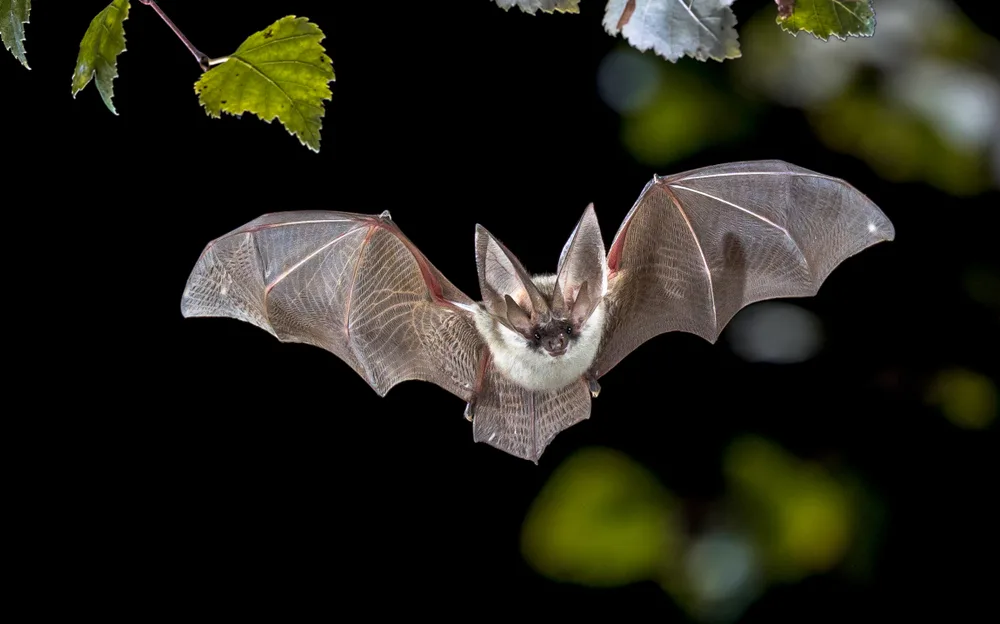Look it! Look it! It’s Freakin’ Bats! We Love Halloween

By Lia Waldrum, AmeriCorps Habitat Restoration Associate
Happy Halloween everyone! And in honor of spooky season and bat lovers everywhere, happy International Bat Week! Bats have a bad reputation among the general public, including yours truly. Creepy images of vampires, rabies and dark scary caves come to mind (and yes I did take a poll). So today we’re going to give bats another chance and see what these furry creatures are really all about. I’ll be learning throughout this as well and at the end we can decide if they still give us the heebie jeebies.
Here’s a crazy fact to start us off — there are more than 1,400 species of bats worldwide which is nearly 20 percent of all mammal species! Bats have been around for more than 50 million years and live all over the world except in the most extreme polar and desert conditions. Here in North Carolina there are 13 native bat species including the Seminole bat, the big brown bat and the southeastern myotis.
Bats come in all shapes and sizes ranging from the Kitti’s hog-nosed bat, which weighs less than a penny, up to the flying fox bat which can have a wingspan up to six feet wide. Now for me personally, this fact takes a point away from Team Bat. The idea of a bat flying around with wings longer than the height of me is rather unappealing.
However it cannot be overlooked that we would likely not have tequila, mangoes, or chocolate without the help of bats. Over 300 species of fruit depend on bats for pollination, including agave which is used to make tequila, and cacao, the main ingredient in chocolate. Bats are also really great at insect control. Each night, bats can eat their body weight in insects which helps protect crops from pests. Team Bat gets a well earned point for all that hard work, making the playing field even once again.
So bats are critical pollinators and really good at eating bugs, which we should all be thanking them for each time we sip on a margarita. But what about all the rumors of the blood sucking and rabies variety? Well they’re not completely unfounded, but they have been blown out of proportion. Of the 1,400+ bat species on the planet, only three species feed on blood. These well named vampire bats live in Central and South America and Mexico (thank goodness), and they primarily feed on animal blood, very rarely human blood. You would have to sleep outdoors in
an area known to have vampire bats around to be at risk. Otherwise consider yourself safe. So we can knock that one off the rumor mill.
And when it comes to rabies, yes, bats along with other mammals such as dogs, raccoons, cats and skunks do sometimes carry rabies. However, less than one percent of bats in the wild have rabies. So that image of the rabid bloodsucking bat some of us have in our heads? Yeah, it’s a figment of our imagination (another point for Team Bat). The best rule of thumb is to just avoid handling bats, especially if they appear sick or injured.
A couple more fun facts about bats— they are the only flying mammal (which means yes they do have belly buttons I knew you were wondering), they aren’t actually blind, they have about the same eyesight as humans, and baby bats are called pups!
So now that we know bats aren’t evil and are actually vital to the health of our environment, it’s important to note that bats could use our help. Bat populations are decreasing around the world– 21 species are critically endangered (face imminent risk of extinction), 83 species are endangered and 109 species are considered vulnerable. The primary cause of decline is human activity such as habitat destruction, wind turbines, hunting, and harmful myths that continue to be perpetuated about bats.
Locally our bats also suffer from a relatively new disease called White-Nose Syndrome which has led to the loss of over six million bats in just eight years. The disease affects hibernating bats and comes from a fungus that grows on the inactive bats. The fungus leads bats to be more active than usual and burn through necessary fat stores that keep them alive throughout the winter.
Though there is no known cure for White-Nose Syndrome yet, scientists are working on various potential treatments including a vaccine and changes to bat habitats to increase chances of survival for our bat friends.
If you’re interested in looking more into what you can do to support bat populations, the Bat Week website has some wonderful tools and resources to get you started.
I’ll be honest, all of the bat pictures I encountered while writing this article made me audibly squeal and scroll past as fast as possible. They’re just not appealing creatures to look at in my opinion. But I’m happily surprised to learn that they’re not the scary creatures I thought they were. That doesn’t mean I’m going to start hanging out in caves with them, but I’m also not willing to give up tequila or mangoes or chocolate, so I would now say I’m firmly on Team Bat.